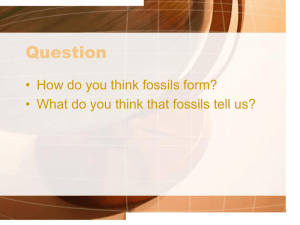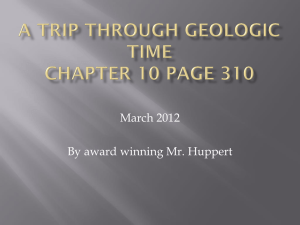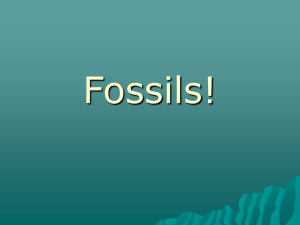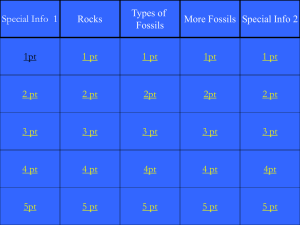FOSSILS-2
advertisement
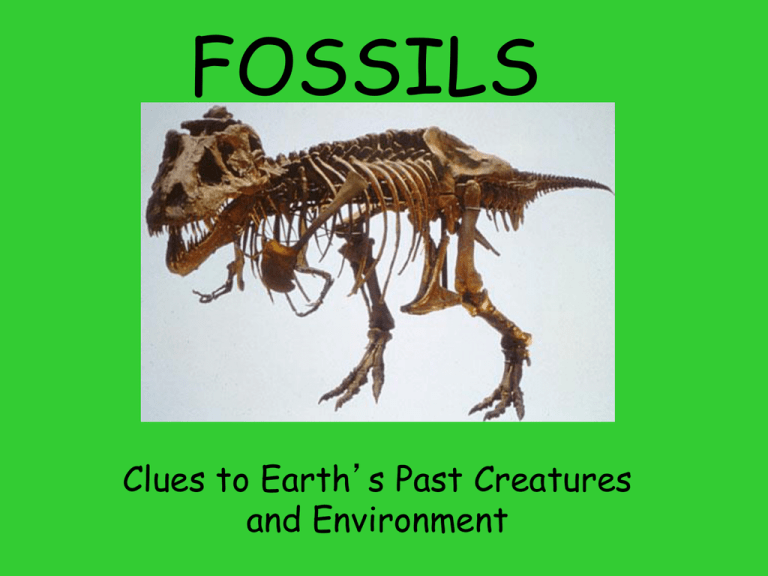
FOSSILS Clues to Earth’s Past Creatures and Environment SC Standard 8-2.2 Summarize how scientists study Earth’s past environment and diverse life forms by examining different types of fossils. What is a fossil? • A fossil is the preserved remains or traces of an organism that lived in the past • Usually fossils are more than 10,000 years old http://www.youtube.com/watch?v=3rkGu0BItKM What do fossils tell us about Earth’s past? • Fossils are clues to: – The diversity of living things throughout Earth’s history – Past climate and surface changes – Changes that have occurred with organisms over time Who studies fossils? • Paleontology is the study of fossils • Scientists who study fossils are called paleontologists How are fossils classified? • Fossils are classified by how they are formed • Types of fossils: – – – – – – Mold fossil Cast fossil Petrified fossil Preserved fossil Carbonized fossil Trace fossil Mold Fossil • Forms when: – Sediments bury an organism – Sediments change into rock by pressure – The organism decays – Leaves a cavity or hollow in the shape of the organism Cast Fossil • Forms when: – A mold is filled with sand or mud – Sediments harden into the shape of the organism Mold and Cast Fossils • Most common form of fossils • Most fossils form when sediment buries a dead organism • Organism most likely lived in or near quiet water (swamp, lake, shallow sea) Petrified Fossil • Also called permineralized fossil • Forms when: – Minerals from groundwater soak into the buried remains of organisms – Minerals replace the organic remains – Changes into rock Preserved Fossil • Forms when: – Entire organisms or parts of organisms are prevented from decaying – Trapped in rock, ice, tar, or amber Carbonized Fossils • Form when: – Organisms or parts are pressed between layers of soft mud or clay – Mud or clay hardens – Squeezes almost all the decaying organism away – Leaves the carbon imprint in the rock Trace Fossils • Forms when: – Mud or sand hardens to stone where a footprint, trail, or burrow of an organism was left behind Dino Tracks The Fossil Record • Millions of fossils have been collected and studied from all over the world • Provides evidence of the history of life on Earth • Shows that different groups of organisms have changed over time http://www.abc.net.au/beasts/fossilfun/burial/default.htm Check for Understanding Test Your Skills Which of the following is least likely to be found as a fossil? a. b. c. d. Clam shell Shark tooth Dinosaur bone Jellyfish imprint Test Your Skills Fossils are usually found in _______? a. b. c. d. Desert land Mud Sedimentary rock Rocks formed inside volcanoes Test Your Skills Fossils of animals found in the La Brea tar pits are examples of what kind of fossils? a. b. c. d. Carbon film Mold fossil Preserved remains Petrified fossil Test Your Skills Marine fossils have been found in exposed rock layers in South Carolina. Which of the following is the best interpretation of this discovery? A. Marine organisms evolved from land-dwelling organisms. B. Parts of South Carolina were once covered by water. C. These organisms could live both in water and on land. D. They were carried by humans to South Carolina. Test Your Skills Select the correct letter for the choices that are all definitely fossils. A. B. C. D. Egyptian Mummy, Ancient Pottery, Worm burrows in sandstone Imprints of rain drops, Trilobite shells, Mud cracks Dinosaur tracks, Mammoth found in ice, Seashells found in limestone Stone Age tools, Giant shark teeth, Seashells found on a beach Test Your Skills Using the choices below, identify the fossils formed by petrification. A. Dinosaur tracks, Black outline of a plant leaf B. Rock-like wood, Rock-like Brachiopod shell C. Mud-filled shape of a gastropod shell, Mammoth droppings D. Insect in amber, Hollow cavity shaped like a trilobite Do Now 1. What is sea-floor spreading? 2. How are mold and cast fossils related?




